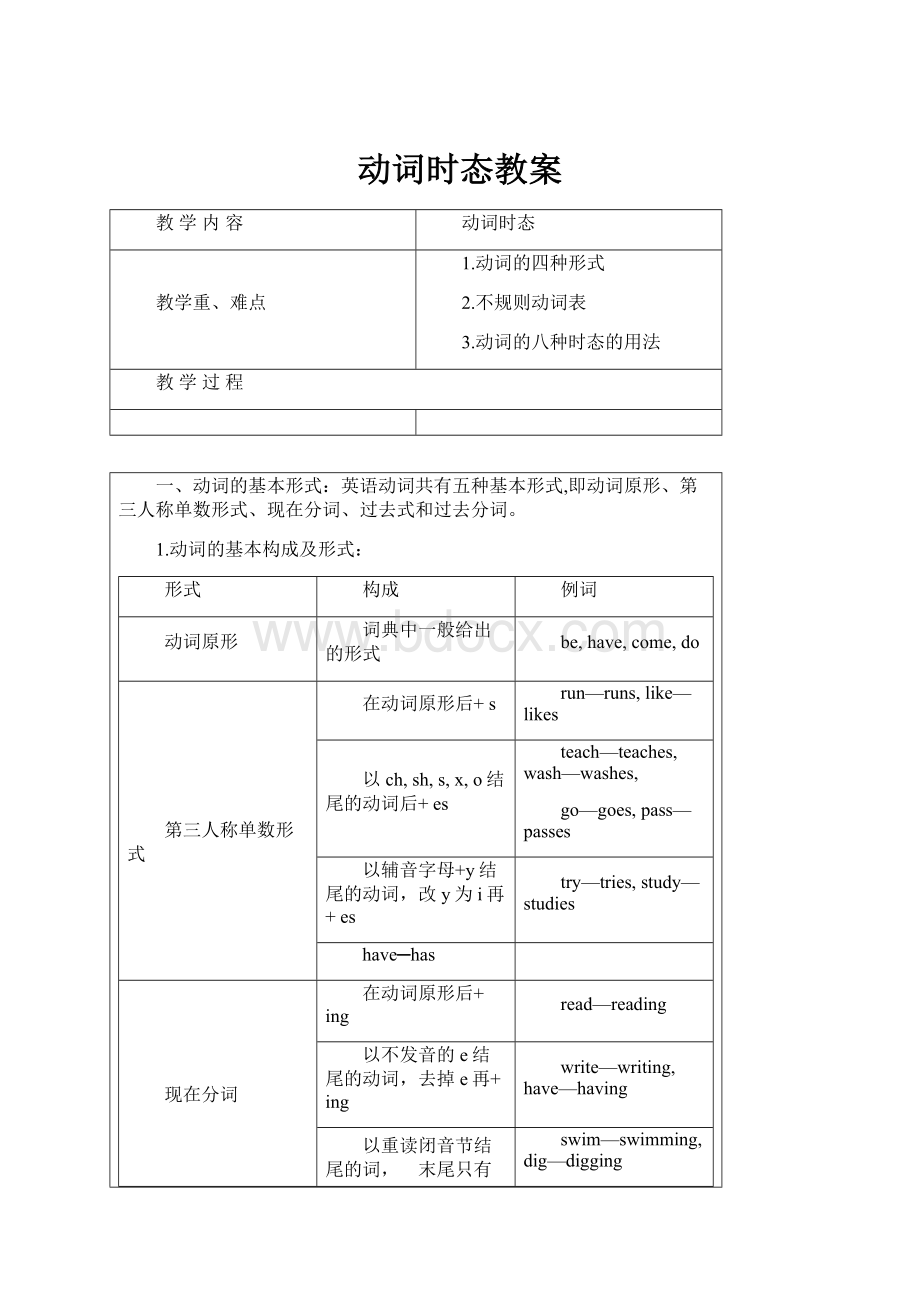动词时态教案.docx
《动词时态教案.docx》由会员分享,可在线阅读,更多相关《动词时态教案.docx(24页珍藏版)》请在冰豆网上搜索。

动词时态教案
教学内容
动词时态
教学重、难点
1.动词的四种形式
2.不规则动词表
3.动词的八种时态的用法
教学过程
一、动词的基本形式:
英语动词共有五种基本形式,即动词原形、第三人称单数形式、现在分词、过去式和过去分词。
1.动词的基本构成及形式:
形式
构成
例词
动词原形
词典中一般给出的形式
be,have,come,do
第三人称单数形式
在动词原形后+s
run—runs,like—likes
以ch,sh,s,x,o结尾的动词后+es
teach—teaches,wash—washes,
go—goes,pass—passes
以辅音字母+y结尾的动词,改y为i再+es
try—tries,study—studies
have─has
现在分词
在动词原形后+ing
read—reading
以不发音的e结尾的动词,去掉e再+ing
write—writing,have—having
以重读闭音节结尾的词, 末尾只有一个辅音字母,双写此字母后再+ing
swim—swimming,dig—digging
少数几个以ie结尾的动词要变ie为y再+ing
die—dying,lie—lying
过去式与过去分词(规则变化)
在动词原形后+ed
work—worked
以辅音字母+y结尾的动词,改y为i再+ed
carry—carried,study—studied
以重读闭音节结尾的词, 末尾只有一个辅音字母,双写此字母后再+ed
stop—stopped,plan—planned
说明:
①词尾ed在清辅音后读/t/;在浊辅音和元音后读/d/;在/t/和/d/后读/d/.
②词尾es或s在/s/,/z/,/t/,/d/后读/z/;在清辅音后读/s/;在浊辅音及元音后读/z/;在/t/,/d/后读/ts/,/dz/.
2.不规则动词的过去式和过去分词:
原型
过去式
过去分词
原型
过去式
过去分词
1.AAA型
cost
cost
cost
put
put
put
cut
cut
cut
read
read[red]
read[red]
hit
hit
hit
set
set
set
hurt
hurt
hurt
shut
shut
shut
let
let
let
hurt
hurt
hurt
2.AAB型
beat
beat
beaten
3.ABA型
become
became
become
run
ran
run
come
came
come
原型
过去式
过去分词
原型
过去式
过去分词
4.ABB型
(1)原型后加d或t:
burn
burnt
burnt
mean
meant
meant
hear
heard
heard
spoil
spoilt
spoilt
learn
learnt
learnt
(2)原型改d为t
build
built
built
send
sent
sent
lend
lent
lent
spend
spent
spent
(3)其他
bring
brought
brought
meet
met
met
buy
bought
bought
pay
paid
paid
catch
caught
caught
say
said
said
dig
dug
dug
sell
sold
sold
feel
felt
felt
shine
shone(shined)
shone(shined)
fight
fought
fought
sit
sat
sat
find
found
found
sleep
slept
slept
get
got
got
smell
smelt(smelled)
smelt(smelled)
hang
hung(hanged)
hung(hanged)
spill
spilt
spilt
have,has
had
had
spit
spat
spat
hide
hid
hid(hidden)
stand
stood
stood
hold
held
held
sweep
swept
swept
keep
kept
kept
teach
taught
taught
lay
laid
laid
tell
told
told
leave
left
left
think
thought
thought
lose
lost
lost
understand
understood
understood
make
made
made
win
won
won
5.ABC型
(1)原型后加n或en:
blow
blew
blown
mistake
mistook
mistaken
draw
drew
drawn
ride
rode
ridden
drive
drove
driven
rise
rose
risen
eat
ate
eaten
see
saw
seen
fall
fell
fallen
show
showed
shown
原型
过去式
过去分词
原型
过去式
过去分词
give
gave
given
take
took
taken
grow
grew
grown
throw
threw
thrown
know
knew
known
write
wrote
writen
(2)过去式后加n或en
break
broke
broken
sink
sunk(sank)
sunken(sunk)
choose
chose
chosen
speak
spoke
spoken
forget
forgot
forgotten
wake
woke
woken
freeze
froze
frozen
(3)改i为a(过去式)和u(过去分词)
begin
began
begun
sing
sang
sung
drink
drank
drunk
swim
swam
swum
ring
rang
rung
(4)其他
be(am,is)
was
been
go
went
gone
be(are)
were
been
lie
lay
lain
do
did
done
wear
wore
worn
fly
flew
flown
二、动词的时态:
在英语中,由于谓语动词发生的时间不同,或表达不同时间存在的状态,谓语动词都要发生相应的变化,这些动词的形式就叫做动词的时态.英语共有16种时态,初中阶段学习9种.现以动词do为例,将这9种时态构成列表如下:
一般
进行
完成
完成进行
现在
一般现在时:
①do②does
现在进行时:
am/is/aredoing
现在完成时:
has/havedone
现在完成进行时:
has/havebeendoing
过去
一般过去时:
did
过去进行时:
was/weredoing
过去完成时:
haddone(初三学)
将来
一般将来时:
①am/is/aregoingtodo②will/shalldo
过去将来
过去将来时:
①was/weregoingtodo②would/shoulddo
1.一般现在时:
(1)构成:
①动词原形②动词第三人称单数形式
(2)形式:
①be动词:
肯定句:
主语+am/is/are+表语(n./pron./adj.)
eg:
Iam/I’mastudent.Youare/You’reastudent.Heis/He’s/Sheis/She’sastudent.
Itis/It’sanapple.Weare/We’re/Youare/You’re/Theyare/They’restudents.
Theyare/They’remine.Itis/It’srainy.
否定句:
主语+am/is/are+not+表语(n./pron./adj.)
eg:
Iamnot/I’mnotastudent.Youarenot/You’renot/Youaren’tastudent.
Heisnot/He’snot/Heisn’tastudent.Sheisnot/She’snot/Sheisn’tastudent.
Itisnot/It’snot/Itisn’tanapple.Wearenot/We’renot/Wearen’tstudents.
Theyarenot/They’renot/Theyaren’tstudents.
Theyarenot/They’renot/Theyaren’tmine.Itisnot/It’snot/Itisn’trainy.
疑问句:
Am/Is/Are+主语+表语(n./pron./adj.)
eg:
AmIastudent?
Areyouastudent?
Ishe/sheastudent?
Isitanapple?
Arewe/you/theystudents?
Aretheyyours?
Isitrainy?
②其它动词:
肯定句:
主语+动词原形/第三人称单数形式(+宾语)(+状语)
eg:
I/You/We/You/TheystudyEnglisheveryday.
He/ShestudiesEnglisheveryday.Itrainseveryday.
否定句:
主语+don’t/doesn’t(第三人称单数)+动词原形(+宾语)(+状语)
eg:
I/You/We/You/Theydon’tstudyEnglisheveryday.
He/Shedoesn’tstudyEnglisheveryday.Itdoesn’traineveryday.
疑问句:
Do/Does+主语+动词原形(+宾语)(+状语)
eg:
DoI/You/We/You/TheystudyEnglisheveryday?
Doeshe/shestudyEnglisheveryday?
Doesitraineveryday?
(3)用法:
①表示经常发生的动作或现在存在的状态
eg:
IgotoschooleverydayexceptSunday.除了星期日,我每天都上学。
(动作)
Thereare50studentsinourclass.我们班上有50名学生。
(状态)
②表示一种客观事实或普遍真理(注:
无论在什么情况下,都用一般现在时,包括在宾语从句中)
eg:
Theearthisround.地球是圆的。
Theteachersaidthesunisbiggerthantheearth.老师说太阳比地球大。
③表示主语的性格、能力、兴趣等心理状态和情感的动词,往往用一般现在时(了解)
eg:
Shelikesbasketballgames.她喜欢篮球比赛。
(兴趣)
Iwantacupoftea.我想喝杯茶。
(心理状态)
④在时间、条件状语从句中用一般现在时表示将来的动作,“主将从现”
关键词:
if,when,assoonas等
eg:
AssoonasIgetthere,I’llcallyouup.我一到那就打电话给你。
Idon’tknowifhewillcometomorrow.Ifhecomes,Iwilltellyou.
我不知道明天他是否会来。
如果他来了,我会告诉你。
Idon’tknowwhenhewillcometomorrow.Whenhecomes,Iwilltellyou.
我不知道明天他什么时候会来。
当他来的时候,我会告诉你。
(4)时间状语(标志):
always,usually,often,sometimes,seldom,onSundays/Mondays/…,
everymorning/afternoon/…/day/week/…/minute/second/Sunday/Monday…
练习:
1.Myfatherisverybusy.He___________(go)toworkearlyeverymorning.
2.Ifhe________harder,hewillcatchupwith(赶上)ussoon.
A.studyB.studiesC.willstudyD.studied
3.Mothertoldmethemoon________(go)aroundtheearth.
2.一般过去时:
(1)构成:
动词的过去式
(2)形式:
①be动词:
肯定句:
主语+was/were+表语
eg:
I/He/She/Itwasthere.We/You/Theywerethere.
否定句:
主语+was/were+not+表语
eg:
I/He/She/Itwasnotthere.We/You/Theywerenotthere.
疑问句:
Was/Were+主语+表语
eg:
WasI/he/she/itthere?
Werewe/you/theythere?
②其它动词:
肯定句:
主语+动词的过去式(+宾语)(+状语)
eg:
I/You/He/She/We/You/Theyworkedthere.Itrainedyesterday.
否定句:
主语+didnot/didn’t+动词原形(+宾语)(+状语)
eg:
I/You/He/She/We/You/Theydidnot/didn’tworkthere.
Itdidnot/didn’trainyesterday.
疑问句:
Did+主语+动词原形(+宾语)(+状语)
eg:
DidI/you/he/she/we/you/theyworkthere?
Diditrainyesterday?
(3)用法:
①表示在过去某一时间发生的动作或存在的状态
eg:
HewenttoBeijingyesterdaymorning.他昨天早上去北京了。
(动作)
Therewere1000studentsinourschoollastyear.我们学校去年有1000名学生。
(状态)
②表示过去经常或反复发生的动作
eg:
Marygotuptoolate,anddidn’thaveenoughtimeforbreakfast.
玛丽起得太迟了,都没有足够的时间吃早饭。
③有些表示主语心理状态的词,用一般过去时时,要注意其含义(了解)
eg:
Ididn’tknowyouwereinParis.我本不知道你在巴黎。
(因为我在说话时,已经知道你在巴黎了.这句话指的是说话之前,所以只能用过去时表示.实际上这句话暗指:
ButnowIknowyouareinParis.)
eg:
Ithoughtyouwereill.我还以为你病了呢。
(但现在我知道你没病)
(4)时间状语:
yesterday,thedaybeforeyesterday,ago,justnow,theotherday(前几天),onceuponatime(从前),intheolddays(在过去的日子里),in1980,whenIwasseven…,
Lastnight/week/year…/Sunday/Monday…,……
练习:
1.Jack_________(begin)towriteabookabouthisjourneylastweek.
2.OnApril18th2004,ourcountry________twoman-madesatellites(人造卫星)intospace.
A.wassentup(发射)B.sentupC.hassentupD.sendsup
3.It________thattheyhadnochangeatthemoment.
A.seemedB.wasseemedC.seemD.isseemed
3.现在进行时:
(1)构成:
am/is/are+动词的现在分词(doing形式)
(2)形式:
肯定句:
主语+am/is/are+现在分词(+宾语)(+状语)
eg:
Iam/I’mworkingnow.Youare/You’reworkingnow.
He/Sheisworkingnow.Itisrainingnow.
We/You/Theyareworkingnow.(缩写形式略,以下同)
否定句:
主语+am/is/are+not+现在分词(+宾语)(+状语)
eg:
I’mnotworkingnow.You’renotworkingnow.
He/Sheisnotworkingnow.Itisnotrainingnow.
We/You/Theyarenotworkingnow.
疑问句:
Am/Is/Are+主语+现在分词(+宾语)(+状语)
eg:
AmIworkingnow?
Areyouworkingnow?
Ishe/sheworkingnow?
Isitrainingnow?
Arewe/you/theyworkingnow?
(3)用法:
①表示此时此刻(说话时)正在进行的动作
eg:
Whoistheteacherwaitingfor?
老师在等谁?
Theteacheriswaitingforherhusband.老师在等她丈夫。
②表示在现阶段正在进行的动作,但不一定说话时动作正在进行
eg:
We’regettingreadyfortheexamthesedays.这些天我们在为考试做准备。
eg:
IamreadingEnglishathomefromfivetosixeverymorning.
我每天早晨5点到6点在家里读英语。
③有些表示位置移动的动词的现在进行时,表示将来即将发生的动作。
如:
go,come,leave,arrive,start,begin,move,stay,die等
eg:
Heiscoming.他就要来了。
WearegoingtoQingdaonextweek.下星期我们要去青岛。
④“am/is/are+always++现在分词”结构,表示经常性或习惯性的动作,带有强烈的感情色彩,或赞扬、喜爱,或讨厌、厌烦。
(初三学)
eg:
You’realwaysgettingreadyforhelpingothers.你总是时刻准备着帮助别人。
(赞扬)
Sheisalwayseatinginclass.他总是在班上吃东西。
(厌烦)
(4)时间状语:
now,atthemoment,atthistime,Look!
Listen!
多数情况要根据上下文确定
eg:
─Whereismyfather?
─Heiscleaningthecar.
练习:
1.Look!
Themen__________(dance)withtheirwives.
2.─Ican’tfindmypen.CanIuseyours?
─Sorry,I_______itnow.
A.amusingB.wasusingC.haveusedD.using
3.NexttermMr.Li____________(leave)forShanghai.
4.过去进行时:
(1)构成:
was/were+动词的现在分词(doing形式)
(2)形式:
肯定句:
主语+was/were+现在分词(+宾语)(+状语)
eg:
I/He/Shewaswritingaletterathomeatsevenyesterdayevening.
You/We/You/TheywerehavinganEnglishclassatthistimeofyesterday.
Itwasrainingatthistimeofyesterday.
否定句:
主语+was/were+not+现在分词(+宾语)(+状语)
eg:
I/He/Shewasnotwritingaletterathomeatsevenyesterdayevening.
You/We/You/TheywerenothavinganEnglishclassatthistimeofyesterday.
Itwasnotrainingatthistimeofyesterday.
疑问句:
Was/Were+主语+现在分词(+宾语)(+状语)
eg:
WasI/he/shewritingaletterathomeatsevenyesterdayevening?
Wereyou/we/you/theyhavinganEnglishclassatthistimeofyesterday?
Wasitrainingatthistimeofyesterday?
(3)用法:
①表示过去某个时刻或过去一段时间正在进行的动作。
eg:
Theywereplayingbasketballatfouro’clockyesterdayafternoon.
昨天下午四点他们在打篮球。
(某个时刻)
Wewereworkingfromseventoelevenlastnight.
我们昨天晚上从七点工作到十一点。
(一段时间)
Itwasr